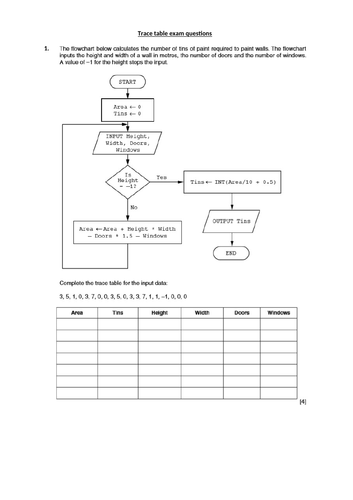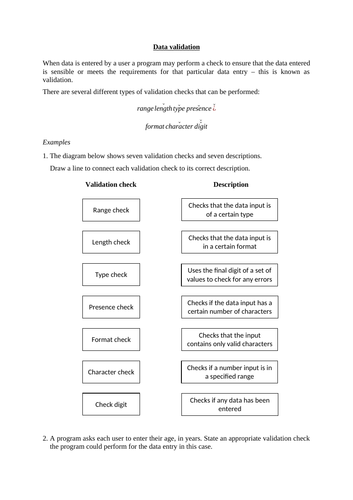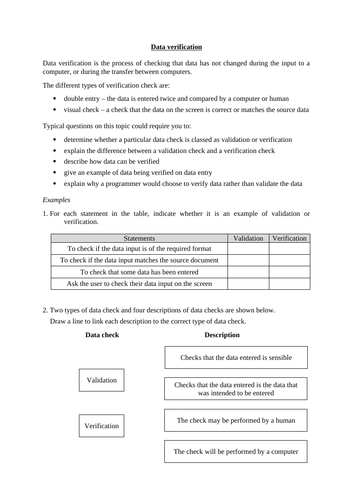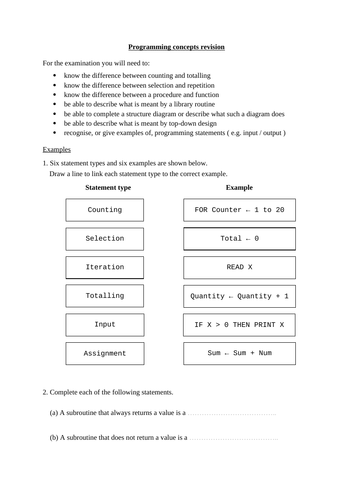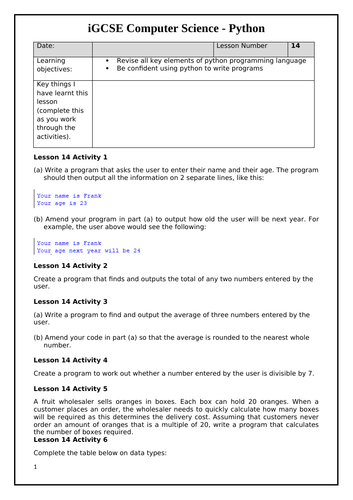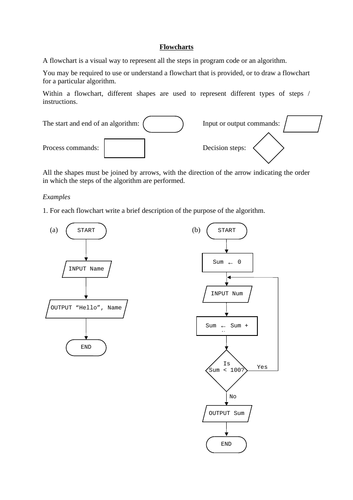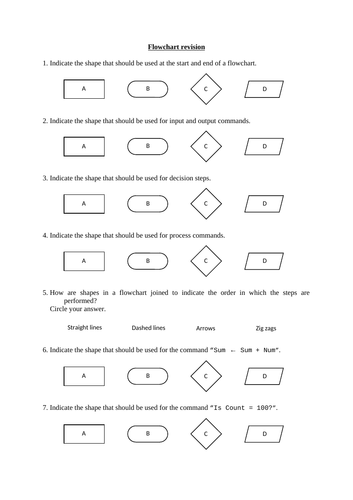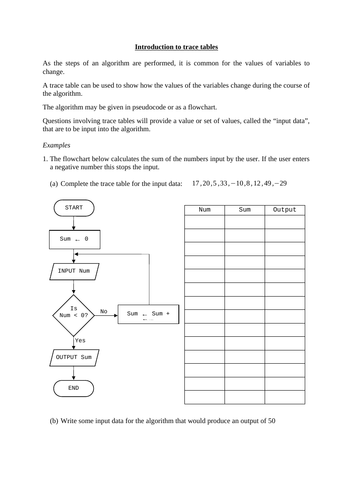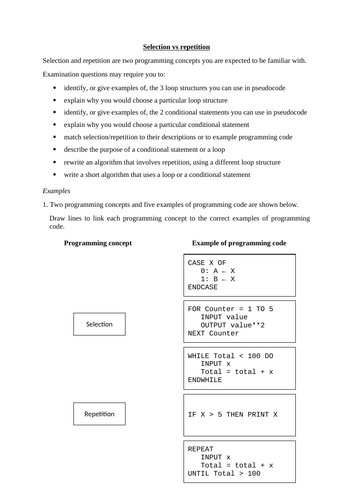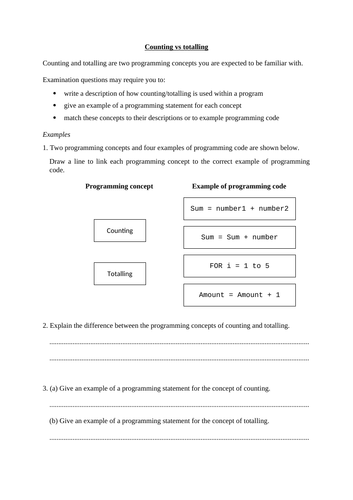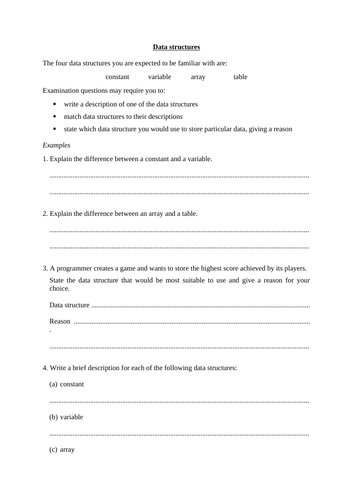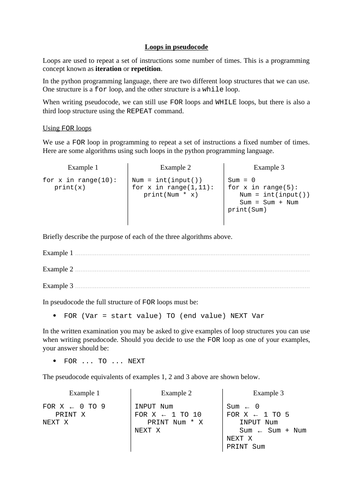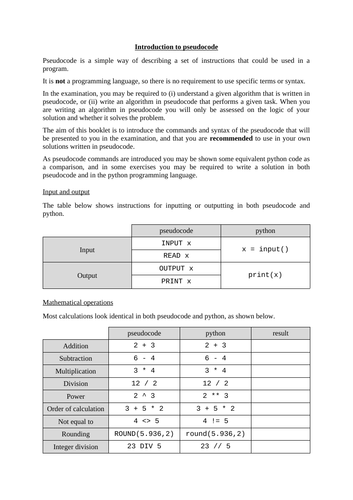31Uploads
12k+Views
7k+Downloads
All resources

Trace table exam questions (iGCSE Computer Science)
This resource is based on a selection of 17 questions on trace tables taken from past papers.
The first document contains the exam questions, which can be printed for your pupils.
The second document is a spreadsheet designed to help the students get the trace tables correct before they fill in the printed document - as they fill in each cell within a trace table, it will stay black if it is correct, but turn red if it is wrong. This means they will be aware of any error as soon as they make it, rather than working through the whole table and only realising at the end that they need to make corrections.
The third document is the answers (mark schemes) to the questions.

Data validation (iGCSE Computer Science)
This short resource introduces the different types of validation checks a computer may perform.
There are some example questions to work through with your group, and answers are provided.

Data verification (iGCSE Computer Science)
This short resource introduces the different types of verification checks a computer or person may perform.
There are some example questions to work through with your group, and answers are provided.

Programming concepts revision (iGCSE Computer Science)
This resource can be used to revise the topic of programming concepts. It briefly covers each of: counting, totalling, selection, repetition, procedures, functions, library routines, structure diagrams, and top-down design.
There are 7 example questions to work through, either as a class or for the pupils to attempt on their own.
Solutions are provided.

Python revision activities
This booklet of activities is designed to help your students revise the key Python programming skills they need for the iGCSE course.
It covers inputs and outputs, calculations, data types, comparison operators, IF statements, FOR loops, WHILE loops, and lists/arrays (1D and 2D).
There are over 30 activities for pupils to work through, including many programming tasks.
The booklet is designed for pupils to work through independently, so they can progress and learn at their own pace and you just support and guide as necessary.
This resource has been updated for the new specification for exams from 2023, so includes some activities working with 2D lists.
Solutions to all activities are included in a separate booklet.

Program development life cycle (0984 iGCSE Computer Science)
This short resource can be used to teach students about the life cycle of program development.
It shows the 4 stages of the cycle and has some brief notes on each stage. There is then a one-page exercise for students to attempt (answers included).

Test data (iGCSE Computer Science)
This short resource introduces the different types of test data that may be used when checking an algorithm performs correctly.
There are some example questions to work through with your group, and answers are provided.

Flowcharts
This 12-page resource introduces how flowcharts can be used as a visual representation of a program, tailored towards the iGCSE Computer Science course.
After introducing the different shapes used for different types of steps or instructions, there are some examples to work through as a group, followed by an exercise for pupils to attempt themselves.
Solutions to the exercise are included, and solutions to the examples are included in the teacher version.

Flowcharts revision
This 7-page resource is designed to help pupils revise the topic of flowcharts for the iGCSE Computer Science course.
It begins with 12 example questions to work through as a group, followed by an exercise with another 12 questions for pupils to attempt themselves.
Solutions to the exercise are included, and solutions to the examples are included in the teacher’s version.

Trace tables - iGCSE Computer Science
This 14-page resource introduces how trace tables can be used to show how the values of variables change during the course of an algorithm.
It begins with 3 examples to work through as a group, followed by an exercise with 11 questions for pupils to attempt themselves. All the trace tables are ready to be completed, so this resource could be used in a printed or electronic form with your class.
Solutions to the exercise are included.

Selection vs repetition (iGCSE Computer Science)
This resource focuses on the two programming concepts of selection and repetition.
It begins with the expected knowledge/skills for this topic, followed by a few examples to work through as a group. Finally, there is an exercise of 12 exam questions taken from past papers.
Solutions (mark schemes) are included for the exercise, and notes/solutions to the introduction and examples are included in the teacher’s version,

Counting vs totalling (iGCSE Computer Science)
This resource focuses on the programming concepts of counting and totalling.
It starts with 3 introductory examples to work through as a group, followed by an exercise for pupils to attempt themselves.
Answers to the exercise are included.

Data structures (iGCSE Computer Science)
This resource focuses on the different data structures pupils are expected to be familiar with for the iGCSE Computer Science course.
It begins with some examples to work through as a group, followed by an exercise with 12 questions for pupils to complete themselves.
Answers to the exercise are included.

1D and 2D arrays / lists in Python
This 25-page booklet covers how 1D and 2D arrays are defined and used in Python. The activities will show pupils how to input data into arrays, sort arrays, find how many elements are in an array, find the index of an element, …
There are nearly 50 activities for pupils to work through, including many programming tasks.
The booklet is designed for pupils to work through independently, so they can progress and learn at their own pace and you just support and guide as necessary.
This resource has been updated for the new specification for exams from 2023. There are 6 activities at the end of the booklet that are designed to help pupils develop the skills and knowledge needed for the 15-mark unseen scenario question at the end of Paper 2.
Solutions to all activities are included in a separate booklet.

Selection in pseudocode (iGCSE Computer Science)
This 19 page resource is designed to introduce students to the use of selection (conditional statements) in pseudocode, as required for the new iGCSE Computer Science specification (from 2023).
The first section covers comparison operators and logical operators. Each command is introduced with some examples and, where appropriate, is compared with equivalent commands in Python. Exercise A has 20 questions for students to practise working with these commands.
The next section focuses on IF statements. The different possible structures of IF statements are introduced with some examples and, where appropriate, are compared with equivalent commands in Python. Exercise B has 19 questions for students to practise writing algorithms that include use of IF statements.
The next section focuses on CASE OF statements. The different possible structures of CASE OF statements are introduced with some examples and, where appropriate, are compared with equivalent commands in Python. Exercise C has 19 questions for students to practise writing algorithms that include use of CASE OF statements.
Full solutions to the exercises are included, and answers to any examples are included in the teacher’s version of the resource.

Iteration (FOR, WHILE & REPEAT loops) in pseudocode (iGCSE Computer Science)
This 23 page resource is designed to introduce students to the use of iteration (FOR, WHILE & REPEAT loops) in pseudocode, as required for the new iGCSE Computer Science specification (from 2023).
The first section covers FOR loops. Some simple FOR loops using Python are given as examples, and then the equivalent commands in pseudocode. Exercise A has over 20 questions for students to practise writing algorithms that include use of FOR loops, including some questions where data is stored in 1D or 2D lists - useful practice in preparation for the 15-mark unseen scenario question at the end of paper 2.
The next section covers WHILE loops. Some simple WHILE loops using Python are given as examples, and then the equivalent commands in pseudocode. Exercise B has over 10 questions for students to practise writing algorithms that include use of a WHILE loop.
The final section covers REPEAT loops. Some simple REPEAT loops in pseudocode are given as examples, and then a contrast is made between WHILE and REPEAT loops. Exercise C has over 10 questions for students to practise writing algorithms that include use of a REPEAT loop.
Full solutions to the exercises are included.

Introduction to pseudocode (iGCSE Computer Science)
This 13 page resource is designed to introduce students to the basics of pseudocode, as required for the new iGCSE Computer Science specification (from 2023).
Section A covers input/output, mathematical operations, comments, declaring variables/constants, and assigning values. Each command is introduced with some examples and, where appropriate, is compared with equivalent commands in Python. Exercise A has 13 questions for students to practise working with these commands.
Section B covers strings and substrings, procedures and functions, declaring an array/list, and working with arrays/lists. Each command is introduced with some examples and, where appropriate, is compared with equivalent commands in Python. Exercise B has 15 questions for students to practise working with these commands.
Answers to the exercises are included, and answers to any examples are included in the teacher’s version of the resource.

Christmas activity with Python
A Christmas-themed activity where students will use/learn programming skills.
This booklet leads students through the creation of a Christmas scene using drawing commands with Python turtle. It does not require any prior programming knowledge, and is designed so that students can progress independently through the tasks.
When I use this with my year 10 classes it takes them around 1 hour to complete.
Example solutions to all the tasks are included in a separate booklet.

Procedures and functions in Python
This booklet introduces how procedures and functions are used within Python, giving pupils lots of programming activities to practise using them.
The booklet is designed for pupils to work through independently, so they can progress and learn at their own pace and you just support and guide as necessary.
The booklet assumes that pupils are familiar with conditional statements, FOR and WHILE loops, and arrays or lists.
Solutions are provided in a separate booklet.

Introduction to Python - printing
This short booklet can be used as an introduction to the Python programming language. After a short introduction activity, pupils practise typing commands into the interactive shell to learn how the print command works.
The booklet is designed for pupils to work through independently, so they can progress and learn at their own pace and you just support and guide as necessary.
Solutions to all activities are included in a separate booklet.

